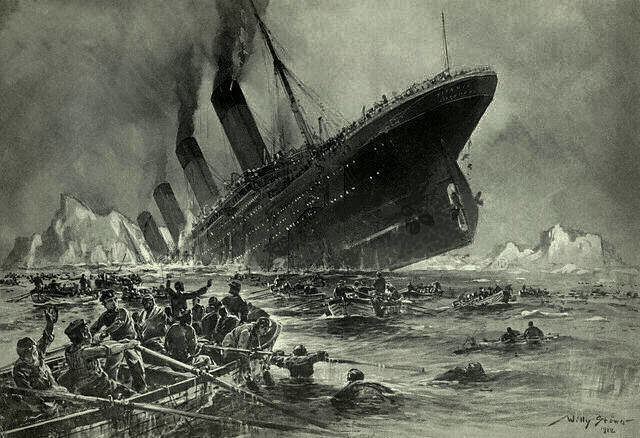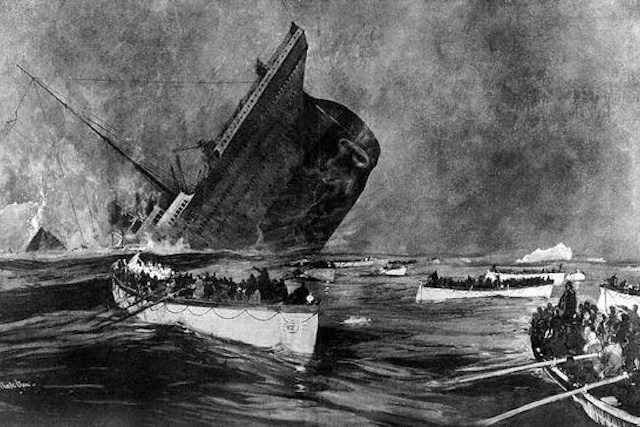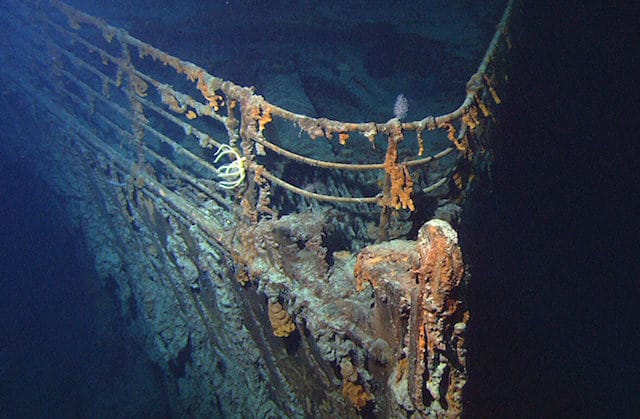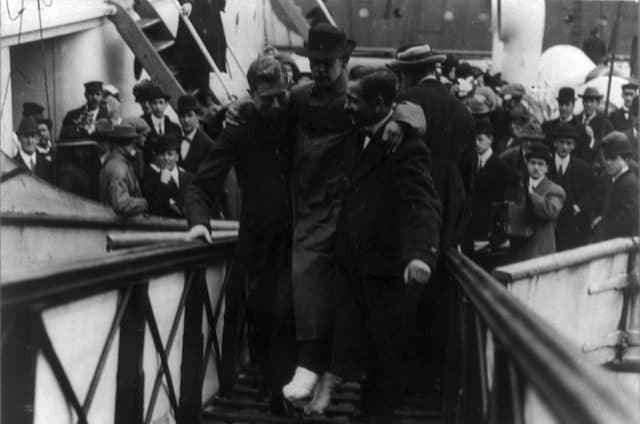The Titanic set out to make headlines as the largest ship on Earth, sailing on its maiden voyage across the Atlantic in April of 1912. Instead, it made history of a different sort as one of history’s greatest follies. The ship hit an iceberg on its fourth day – exactly 105 years ago today, to be exact – 400 miles off the coast of Nova Scotia, and sank within two hours and forty minutes. Somewhere in the ballpark of 1,500 unfortunate victims, who mostly died by being in extremely cold, 28 degree (Fahrenheit) water. If you thought water couldn’t get colder than freezing, think about salt.
But looking deeper at the history of the Titanic, you’ll find complex tales of people who acted decisively when an unforeseen catastrophe struck. You’ll see just over 700 stories of people who survived a disaster that might not have made it out of the Atlantic alive if not for a bit of luck. Among those fortunate survivors were…
10. Frank Prentice – Crew (Assistant Storekeeper)
Right before the Titanic made its final plunge into the ocean, the ship’s stern rose perpendicular to the water briefly, before sinking back down. It was there that crewman Frank Prentice, one of the last people to make it off the Titanic alive, decided to jump off with two of his comrades. One of his associates suffered a painful fall by hitting the propeller on the way down, but Prentice made it clear 100 feet down, where he stuck with his dying friend in the water before eventually being picked up by a lifeboat.
Prentice’s story is easy to verify, because his watch stopped at 2:20 a.m. – the exact minute that the Titanic sank. Remarkably, Prentice survived a second shipwreck when serving aboard the Oceanic in the First World War.
9. The Eight 3rd Class Chinese Passengers

One thing you’ll be surprised by, if you read the actual history of the Titanic evacuation, is that it was a highly civilized process. A lot of people followed the orders of the officers and were happy to give up their seats on the lifeboats for women, children, and the less fortunate without being prompted. If you want to hypoethetically explore your chances of survival on an early 20th century shipwreck if you threw chivalry out the window, look no further than the eight Chinese passengers who all sailed under a single ticket. The band of Cantonese sailors were put out of work due to the coal strike and were on their way back to Hong Kong.
Their names varied, depending on various immigration records. When the iceberg struck, seven of them simply snuck into the lifeboats before they were prepped for unloading and hid under the blankets. Five made it out alive. The eighth sailor was picked up out of the sea by the life boat 14 (the one that picked up Harold Phillimore – we’ll get to him shortly). Combined with the survival of the Titanic’s sole Japanese passenger, the chances of an Asian surviving the Titanic was a pretty solid 7 for 9.
8. Olaus Jorgensen Abelseth – 2nd Class Passenger

Olaus Jorgensen Abelseth was a Norweigan-born livestock farm herder in South Dakota who was returning from a trip to visit relatives when he boarded the Titanic with five family members. One of the ways that an adult male could have found a place on the lifeboats when the Titanic sank was to have ample sailing experience, since the crew could only be stretched so far on the 20 lifeboats they needed to deploy.
Abelseth had six years of experience as a fisherman and considered answering the call for sailors, but his brother-in-law and cousin said they couldn’t swim so he decided to stay with them to ensure everyone’s survival in his family. When the ship went under, Abelseth got caught up in a line and lost hold of his family members. He swam twenty minutes in the water before finding his way to a lifeboat, and worked to revive boat occupants who had also been in the icy water while on the boat.
7. Hugh Woolner and Mauritz Björnström-Steffansson – 1st Class Passsengers
Hugh Woolner and Mauritz Björnström-Steffansson were sitting in the smoking room when they heard the fatal iceberg collision. After escorting one of their female friends to the lifeboats and helping with the unloading process, they waited on the lower deck as the boats were going down and decided to make a jump onto the last lifeboat as it was being lowered. This was within 15 minutes of the Titanic’s eventual demise, so it was pretty much a “now or never” attitude.
Bjornstrom-Steffanson made it on board but Woolner hit the side of the boat and bounced off. His fingers briefly caught the side but slipped, when Steffansson grabbed him as he was dangling over the ocean. He was eventually helped onto the boat. It must have been a dramatic site.
6. Charles Joughin – Crew (Chief Baker)

Most people in the 28 degree water died of hypothermia within 15 to 30 minutes, but Charles Joughin is a testament that every rule of nature has exceptions. Joughin took to drinking when the Titanic hit the iceberg (although to his credit, he also was quite helpful in throwing deck chairs into the sea so people would have floatation devices) and when the ship went under, Joughin casually swam around for over two hours until making his way to one of the life boats at the crack of dawn.
Survival experts link Joughin’s success to the way that the alcohol raised his body temperature, and the fact that he claimed to never have his head fully submerged in the water. Some critics doubt just how long Joughin was in the water but the fact remains that eye witnesses on the lifeboat saw him swimming after the ships were adrift.
5. Richard Norris Williams – 1st Class Passenger

Richard Norris Williams was traveling first class to a tennis tournament in the States with his father. After the iceberg hit, the two remained relatively low-key, asking for the bar to be opened up and passing time in the exercise room (they did also stop to rescue a trapped passenger), but that didn’t make the actual sinking any less dramatic. Richard watched his dad crushed by a funnel, before being carried away by the resulting wave to what was known by the ship’s schematics as Collapsible A. It was one of two boats that didn’t have time to be properly loaded.
In this case, the boat capsized before turning right side up and was filled with water. Norris’s legs were so debilitated from the water that the doctor aboard the Carpathia recommended amputation. He decided against it, and eventually worked his legs back to functionality. He ended up continuing a tennis career that saw him winning the 1924 Olympic gold medal. He also served with distinction in World War I.
4. Rhoda “Rosa” Abbott – 3rd Class Passenger

Everyone knows the “women and children” first rule, but what many don’t know is that it was even crueler than you think. If you were 13 or older you were no longer considered a child, and that didn’t sit well with 3rd class passenger and mother Rhoda Abbott, who was not planning on abandoning her two sons, aged 13 and 16. A soldier with the Salvation Army and strong-willed single mother, Rhoda grabbed each one by the hand and jumped over the rail as the ship was going down.
When she emerged, neither of her sons had surfaced with her. They were both taken by the undertow. Like Norris Williams, Abbott surfaced to Collapsible A, which meant that her legs were also in decrepit condition. She spent two weeks hospitalized but holds the distinction of being the only woman to fall into the Atlantic from the Titanic and survive.
3. Harold Charles Phillimore – Crew (Steward)

James Cameron’s creation of Rose Decatur (played by Kate Winslet) is fictional , but her inspiration might have come from Seward Harold Phillimore, who was discovered clinging to a piece of floating debris among a sea of dead bodies by the last lifeboat to go back for survivors.
Phillimore shared the piece of driftwood with another man (unlike Rose, who selfishly let the love of her life go), but over the course of the 45 minutes between the Titanic’s sinking and his eventual rescue the other man (whose name is lost to history) suddenly drifted off into the ocean. Phillimore ended up having a distinguished career on the sea, earning the Mercantile Marine War and General Service medals.
2. Harold Bride – Marconi Wireless Company

Harold Bride was one of two telegraph operators for the Marconi Wireless Company, whose job was mainly to pass along messages between the ship’s passengers and the mainland. But he was also obligated to pass along navigational messages and warnings from other ships. This would make Bride and colleague James Phillips the MVPs for working the telegraph like there was no tomorrow. They were even given permission to abandon their posts, but stayed on until the ship’s very last minutes.
It was only as the water was filling up their room that they started to notice it was time to go. Both men made it onto the ship’s last lifeboat, known by the ship’s schematics as Collapsible B, which was turned upside down in the water. Bride’s feet were so crushed frozen he could barely make it up the rescue ladder when the Carpathia came.
As he passed a dead body getting up the ladder, he later realized that it was his comrade Phillips, who had passed during the night. Bride didn’t like talking about the Titanic because he was “deeply disturbed by the whole experience, particularly by the loss of his colleague and friend Jack Phillips.”
1. Charles Lightoller – 2nd Officer

Charles Lightoller started a life on the sea with an apprenticeship at the age of 13 and had already been to hell and back by the time he sailed with the Titanic as its second officer. By the time he signed on to the White Star line, he had already survived a shipwreck in Australia, a cyclone on the Indian ocean, and had to hitchhike all the way from Western Canada to England when he was unsuccessful in prospecting for gold in the Yukon and completely broke.
When the ship hit the iceberg, Lightoller was one of the first to start lowering lifeboats. At around 2:00 a.m. (20 minutes before the sinking), he was ordered by his superior officer to get into the lifeboat, to which he replied, “not damn likely.” He eventually swam to the overturned Collapsible B and maintained order and morale among survivors who had all been thrown into the Atlantic, and prevented it from capsizing by having the men rock from side to side. Lightoller was the very last person to be rescued form the Titanic nearly four hours after the Carpathia picked up its first survivor. As the most senior officer to survive, he was also the star witness at the congressional hearing.